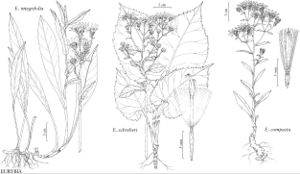Difference between revisions of "Eurybia schreberi"
Gen. Sp. Aster., 137. 1832.
FNA>Volume Importer |
imported>Volume Importer |
||
| (One intermediate revision by the same user not shown) | |||
| Line 8: | Line 8: | ||
}} | }} | ||
|common_names=Schreber’s aster | |common_names=Schreber’s aster | ||
| + | |special_status={{Treatment/ID/Special_status | ||
| + | |code=F | ||
| + | |label=Illustrated | ||
| + | }}{{Treatment/ID/Special_status | ||
| + | |code=E | ||
| + | |label=Endemic | ||
| + | }} | ||
|basionyms={{Treatment/ID/Basionym | |basionyms={{Treatment/ID/Basionym | ||
|name=Aster schreberi | |name=Aster schreberi | ||
| Line 64: | Line 71: | ||
|publication title=Gen. Sp. Aster., | |publication title=Gen. Sp. Aster., | ||
|publication year=1832 | |publication year=1832 | ||
| − | |special status= | + | |special status=Illustrated;Endemic |
| − | |source xml=https:// | + | |source xml=https://bitbucket.org/aafc-mbb/fna-data-curation/src/2e0870ddd59836b60bcf96646a41e87ea5a5943a/coarse_grained_fna_xml/V19-20-21/V20_860.xml |
|tribe=Asteraceae tribe Astereae | |tribe=Asteraceae tribe Astereae | ||
|genus=Eurybia | |genus=Eurybia | ||
Latest revision as of 20:06, 5 November 2020
Plants (20–)40–110 cm, in ± dense clones (with sterile rosettes on short rhizomeds); rhizomes branched, long. Stems 1, erect, simple, straight, proximally glabrous or sparsely villous, distally densely villous. Leaves basal and cauline, margins coarsely serrate (proximal) to serrate (distal), strigoso-ciliate, teeth (15–30 per side) mucronulate, apices acuminate, abaxial faces sparsely strigose, long-stipitate-glandular on veins, adaxial sparsely villous, more densely so on veins; basal withering by flowering, petiolate (55–180 mm), bases sheathing, blades broadly ovate, 55–110 × 48–95 mm, bases cordate (with mostly deep, rectangular sinuses); cauline petiolate to (distal) subsessile, petioles (4–100 mm) ± winged, ± clasping, blades ovate to broadly lanceolate, 27–135 × 7–112 mm, bases cordate (sinuses narrower) to rounded or cuneate-rounded; distal (arrays) sessile, ovate to lanceolate, 6–70 × 1–27 mm. Heads 15–100+ in flat-topped, corymbiform arrays. Peduncles sparsely to moderately villous, sparsely glandular; bracts 0–1, linear. Involucres cylindro-campanulate, 5.5–7.5 mm, equal to or shorter than pappi. Phyllaries 23–32 in 4–5 series, oblong (outer) to lanceolate (inner), strongly unequal, bases indurate, dark green zones in distal 1/4 or less (outer), often confined to narrow strip along midnerves or none (inner), margins narrowly scarious, densely villoso-ciliate, apices ± loose, obtuse to rounded, faces glabrous or sparsely villosulous, sometimes sparsely stipitate-glandular. Ray florets 6–12; corollas white, 10.5–13 × 1.5–2.1 mm. Disc florets 12–20(–30); corollas yellow, 5–6.8 mm, slightly ampliate, tubes (3.2–3.8 mm) longer than campanulate throats (1.1–1.9 mm), lobes erect to slightly spreading, lanceolate, (0.9–)1.1–1.5(–1.9) mm. Cypselae brown, fusiform to cylindro-obconic, compressed, 3.2–3.7 mm, ribs 6–12, faces glabrous or sparsely strigillose; pappi of (65–70) orangish to burnt orange (fine, barbellulate, sometimes apically clavellate) bristles 5–6.8 mm, ± equaling disc corolla. 2n = 54.
Phenology: Flowering late summer–early fall.
Habitat: Damp to mesic deciduous (maple, elm, oak), mixed woods, thickets, shaded roadbanks
Elevation: 0–1200 m
Distribution

Ont., Conn., Del., Ill., Ind., Iowa, Ky., Maine, Md., Mass., Mich., N.H., N.J., N.Y., Ohio, Pa., R.I., Tenn., Vt., Va., W.Va., Wis., introduced in Europe (Scotland).
Discussion
Eurybia schreberi is rare or extirpated in a many states at the northern limit of its range.
Selected References
None.
